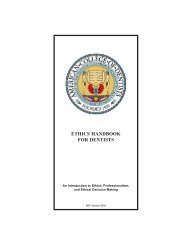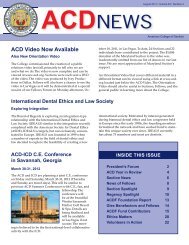Journal of the American College of Dentists
Journal of the American College of Dentists
Journal of the American College of Dentists
Create successful ePaper yourself
Turn your PDF publications into a flip-book with our unique Google optimized e-Paper software.
Students’ Views on Ethics<br />
36<br />
Failing to tell parents and<br />
patients about <strong>the</strong> risks<br />
and alternatives <strong>of</strong> CBCT<br />
scans is an example <strong>of</strong><br />
misrepresentation<br />
because it fails to achieve<br />
truthful communication<br />
and intellectual integrity.<br />
successful treatment <strong>of</strong> patients. In this<br />
respect, <strong>the</strong> pr<strong>of</strong>essional is fulfilling <strong>the</strong><br />
principle <strong>of</strong> beneficence, or <strong>the</strong> ethical<br />
duty to promote <strong>the</strong> patient’s welfare.<br />
However, <strong>the</strong> practice <strong>of</strong> doing good<br />
becomes much overrepresented with<br />
respect to <strong>the</strong> current trends <strong>of</strong> using <strong>the</strong><br />
CBCT in practice. Consider <strong>the</strong> simple<br />
fact that some specialists admit to using<br />
CBCT scans to screen all patients for<br />
treatment. This gives heavy consideration<br />
to <strong>the</strong> ethical principle <strong>of</strong> nonmaleficence,<br />
which holds <strong>the</strong> duty to refrain from<br />
harming <strong>the</strong> patient. To do so, <strong>the</strong> dentist<br />
is obligated to keep his or her knowledge<br />
and skills current, presumably to avoid<br />
<strong>the</strong> introduction <strong>of</strong> harmful practice.<br />
Prescribing a CBCT scan for all patients,<br />
regardless <strong>of</strong> whe<strong>the</strong>r <strong>the</strong> patient has<br />
indications for three-dimensional imaging<br />
or if o<strong>the</strong>r methods producing less<br />
radiation can be used to achieve <strong>the</strong><br />
same clinical outcome is thus an example<br />
<strong>of</strong> unethical behavior. Fur<strong>the</strong>rmore, a<br />
breach <strong>of</strong> nonmaleficence occurs when<br />
dentists justify <strong>the</strong> use <strong>of</strong> such scans for<br />
<strong>the</strong>ir appeal to children who see <strong>the</strong> 3D<br />
images as a “fun” part <strong>of</strong> treatment, as<br />
was reported by Bogdanich and McGinty<br />
(2010). Again, in <strong>the</strong> absence <strong>of</strong> specific<br />
clinical objectives for attaining such<br />
images, a discussion that weighs <strong>the</strong><br />
benefits <strong>of</strong> using CBCT against <strong>the</strong> risks<br />
cannot even be approached, and <strong>the</strong><br />
dentist appears to be engaging solely<br />
in <strong>the</strong> harmful practice <strong>of</strong> exposing<br />
radiosensitive organs to radiation.<br />
Still, perhaps no greater ethical issue<br />
can be extracted from this situation<br />
than <strong>the</strong> one regarding <strong>the</strong> principle<br />
<strong>of</strong> veracity or <strong>the</strong> duty to communicate<br />
truthfully. The <strong>American</strong> Dental<br />
Association Principles <strong>of</strong> Ethics and<br />
Code <strong>of</strong> Pr<strong>of</strong>essional Conduct explicitly<br />
maintains that “dentists shall not<br />
represent <strong>the</strong> care being rendered to<br />
<strong>the</strong>ir patients in a false or misleading<br />
manner,” citing misrepresentation <strong>of</strong><br />
fact or even omission <strong>of</strong> fact that would<br />
o<strong>the</strong>rwise make a statement not materially<br />
misleading as examples <strong>of</strong> false and<br />
misleading behavior. For example, if<br />
parents were honestly informed that<br />
<strong>the</strong>ir child faces a 1-in-10,000 risk <strong>of</strong><br />
developing cancer from a single CBCT<br />
scan, it is unlikely that parents would<br />
hinge <strong>the</strong>ir decision-making process on<br />
<strong>the</strong> same factors as <strong>the</strong>y would have<br />
before this information was presented.<br />
Instead, parents would rightfully seek<br />
more information regarding <strong>the</strong> need for<br />
such a scan in <strong>the</strong>ir child’s specific case,<br />
which seems wrongly insignificant<br />
when <strong>the</strong>se scans are “routine” practice.<br />
Therefore, failing to tell parents and<br />
patients about <strong>the</strong> risks and alternatives<br />
<strong>of</strong> CBCT scans is an example <strong>of</strong> misrepresentation<br />
because it fails to achieve<br />
truthful communication and intellectual<br />
integrity. Also, since informed consent<br />
ultimately asks <strong>the</strong> patient to weigh <strong>the</strong><br />
treatment benefits against <strong>the</strong> risks,<br />
<strong>the</strong> omission <strong>of</strong> information regarding<br />
<strong>the</strong> amount <strong>of</strong> radiation in CT scans<br />
disregards <strong>the</strong> ethical principles <strong>of</strong><br />
veracity and autonomy.<br />
The ADA Principles <strong>of</strong> Ethics and<br />
Code <strong>of</strong> Pr<strong>of</strong>essional Conduct also<br />
makes reference to potential financial<br />
incentives hidden in recommendations<br />
made to patients, holding that dentists<br />
“must take care not to exploit <strong>the</strong> trust<br />
inherent in <strong>the</strong> dentist-patient relationship<br />
for <strong>the</strong>ir own financial gain.” From<br />
<strong>the</strong> article by Bogdanich and McGinty<br />
(2010), it is clear that <strong>the</strong>re is widespread<br />
violation <strong>of</strong> such ethical practice.<br />
<strong>Dentists</strong> are open to <strong>the</strong> economics <strong>of</strong><br />
<strong>the</strong> CBCT because it appears to be a<br />
quick and easy solution, with “more<br />
pr<strong>of</strong>it per unit chair time,” to treating<br />
common dental problems.<br />
Some scenarios allow orthodontists to<br />
use a digital camera to acquire clinical<br />
images instead <strong>of</strong> <strong>the</strong> CBCT, which<br />
would require about 30 extra chairside<br />
2011 Volume 78, Number 4





